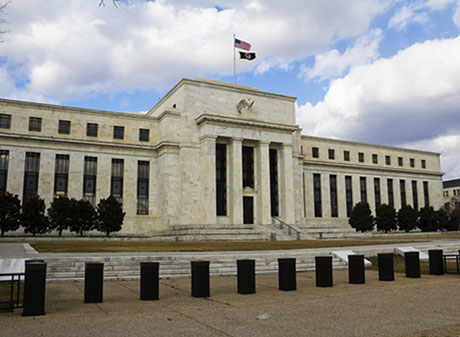The Fed and a Standing Repo Facility: A Follow-Up

Our March 6 post, “Why the Fed Should Create a Standing Repo Facility,” generated a considerable amount of discussion among industry experts. Many people seemed broadly sympathetic to the proposal, while others expressed skepticism. The purpose of this post is to follow up with some additional thoughts on how we think a repo facility could help the Federal Open Market Committee (FOMC) effectively and efficiently implement monetary policy with “minimally ample” reserves.
Reserve Demand versus Interest Rate Control
The motivation for establishing a standing repo facility is twofold:
- First, the facility could be used to support interest rate control by establishing a ceiling on repo rates, thereby guarding against unwanted spikes in money market rates. The use of a ceiling tool for this purpose would be seen as enhancing the monetary policy operating regime of the FOMC.
- Second, the facility could be used to reduce the demand for reserves for any given rate of interest on excess reserves.
While these two motivations are mutually attainable with the same facility, they are conceptually distinct goals. Whether the facility aided in one or both goals would depend on the choice of parameter settings, including the counterparties and offering rate. It would be possible to structure the facility in a manner that reduces reserve demand without serving as a strict ceiling tool. In what follows, we focus our discussion on minimizing reserve demand.
Minimally Ample Reserves
Why the desire to minimize the demand for reserves? In short, because it accords with the FOMC’s stated preference to operate a floor system with the minimum level of reserves necessary to permit the efficient and effective conduct of monetary policy: “minimally ample reserves” for short.See the March 2019 statement on Balance Sheet Normalization Principles and Plans. This view was reiterated by Federal Reserve Chairman Jerome Powell on March 8:Powell, Jerome H. “Monetary Policy: Normalization and the Road Ahead.” Speech at the 2019 SIEPR Economic Summit, Stanford Institute of Economic Policy Research, Stanford, Calif., March 8, 2019.
The Committee has long said that the size of the balance sheet will be considered normalized when the balance sheet is once again at the smallest level consistent with conducting monetary policy efficiently and effectively. Just how large that will be is uncertain, because we do not yet have a clear sense of the normal level of demand for our liabilities.
The stated uncertainty over what constitutes “minimally ample” is significant. Present estimates—based in part on survey questions posed to bankers—place the number north of $1 trillion. (Reserves are currently at $1.6 trillion.)
Reported demand, however, takes as given the present institutional setting. We think there is reason to believe that reported reserve demand could fall to much lower levels if respondents knew they had access to a standing repo facility that worked differently than the discount window presently in place.
How Could a Repo Facility Reduce the Demand for Reserves?
Banks hold reserves for a variety of reasons. First and foremost, they need reserves to meet their reserve requirements and to make interbank payments. But these two factors have influenced the demand for reserves for decades, including before the financial crisis when reserve balances where under $20 billion.
Since the financial crisis, banks are now using reserves to help meet liquidity regulations, such as the liquidity coverage ratio (LCR) and resolution planning. While U.S. Treasuries are given equal weight with reserves in the calculation of high-quality liquid assets (HQLA) for the LCR, they are evidently not considered equivalent for resolution purposes.
Internal liquidity stress tests apparently assume a significant discount on Treasury securities liquidated in large volumes during times of stress, so that Treasuries are not treated as cash-equivalent. We have heard that banks occasionally feel under supervisory pressure to satisfy their HQLA requirements with reserves rather than Treasuries.
Perhaps regulators are taking their cue from the parameters that presently govern the discount window: The penalty rate is set 50 basis points above the target range for the federal funds rate, and longer-duration Treasury securities are given noticeable haircuts.
As we mentioned in our earlier post, a study by the Federal Reserve Bank of New York suggests that eight large banks may want to hold close to $800 billion in precautionary reserves to cover their immediate liquidity needs in times of stress. The desire to hold this level of precautionary balances for resolution purposes would be significantly curtailed if the Fed made available a standing repo facility that offered a lower lending rate and stood ready to accept U.S. Treasury securities at little or no discount.
With such a facility in place, regulators should feel more comfortable in treating U.S. Treasuries on par with reserves for resolution purposes. For a judiciously chosen offering rate, it is doubtful that the facility would be used very much (if at all) during normal day-to-day operations. But whether or not it is used is unimportant for how its mere presence is likely to affect reserve demand.
Who Should Have Access?
Under current regulation, only large bank holding companies must make provisions for resolution, and their banks are able to hold reserves as part of this plan. So, ideally, the facility should be open to these banks.
Most of the banks associated with resolution planning are large in terms of total assets; however, there are some smaller banks as well. Of course, we do not think the facility has to be restricted only to those banks that file resolution plans. The choice of counterparties would also determine how the facility could be used for interest rate control.
Which Securities?
The repo facility we have in mind would only accept U.S. Treasury securities. The primary reason to restrict acceptance to U.S. Treasuries is to encourage the use of these securities by banks in meeting their liquidity regulations.
In addition, if the facility accepts only high-quality government securities, the possibility of stigma associated with using the facility should be low. The effect of reducing stigma, however, is only relevant in the case when the facility is to be used for interest rate control. That is, we do not expect the facility to be used on a daily basis for resolution purposes. It would only be used if the bank is in resolution, and stigma is not likely to be a consideration for a bank undergoing liquidation.
What Offering Rate?
The setting of the offering rate on the repo facility is key in affecting its function and usage. For reducing the demand for reserves, the rate could be set above market repo rates (to discourage everyday usage) but not so high that it is a huge discount in resolution plans (which we noted could be part of the reason that banks do not consider the discount window in their plans).
Policymakers may want to consider setting the rate several basis points above the upper end of the target range for the federal funds rate. The secured overnight financing rate (SOFR)—which is a broad measure of the cost of borrowing cash overnight collateralized by Treasury securities—has been trading within the FOMC’s target range for some time. So, a facility with an offering rate above the target range would not be attractive to use in daily operations but would be available for resolution planning purposes.
However, the SOFR has traded above the target range in the past, so the level of the offering rate should be carefully determined, and its setting should be reviewed periodically. And, even with the rate above the target range, the facility could see usage around quarter ends when market repo rates tend to spike. In this case, the facility would be dampening volatility and aiding in interest rate control periodically.
How Could a Repo Facility Impact Reserve Demand?
There is considerable uncertainty as to how regulations are affecting reserve demand. But, one can look at which banks have reduced their reserve holdings since the peak in 2014 to get some indication. A recent blog post on which banks have been shedding reserves showed that nearly 70% of the decline in reserves is traced to banks that do not face liquidity regulations. This suggests that liquidity-regulated banks are indeed demanding sizable reserve holdings.
If one assumes that liquidity-regulated banks instead acted like their nonliquidity-regulated counterparts, we estimate that reserves could easily be $175 billion to $300 billion lower to date. Moreover, keep in mind that policymakers have in place a policy of draining reserves from the banking system at least until October, so this number is likely a lower bound. Also, recall that the New York Fed study suggested liquidity-induced demand for reserves is near $800 billion.
These numbers, of course, are only guesstimates. The only way to know the true impact of how a repo facility could reduce reserve demand is to establish the facility and continue to let reserves decline organically as currency continues to grow.
Notes and References
1 See the March 2019 statement on Balance Sheet Normalization Principles and Plans.
2 Powell, Jerome H. “Monetary Policy: Normalization and the Road Ahead.” Speech at the 2019 SIEPR Economic Summit, Stanford Institute of Economic Policy Research, Stanford, Calif., March 8, 2019.
Additional Resources
- On the Economy: Why the Fed Should Create a Standing Repo Facility
- On the Economy: Which Banks Have Been Shedding Reserves?
- On the Economy: Banks’ Demand for Reserves in the Face of Liquidity Regulations
Citation
David Andolfatto and Jane E. Ihrig, ldquoThe Fed and a Standing Repo Facility: A Follow-Up,rdquo St. Louis Fed On the Economy, April 19, 2019.
This blog offers commentary, analysis and data from our economists and experts. Views expressed are not necessarily those of the St. Louis Fed or Federal Reserve System.
Email Us
All other blog-related questions



